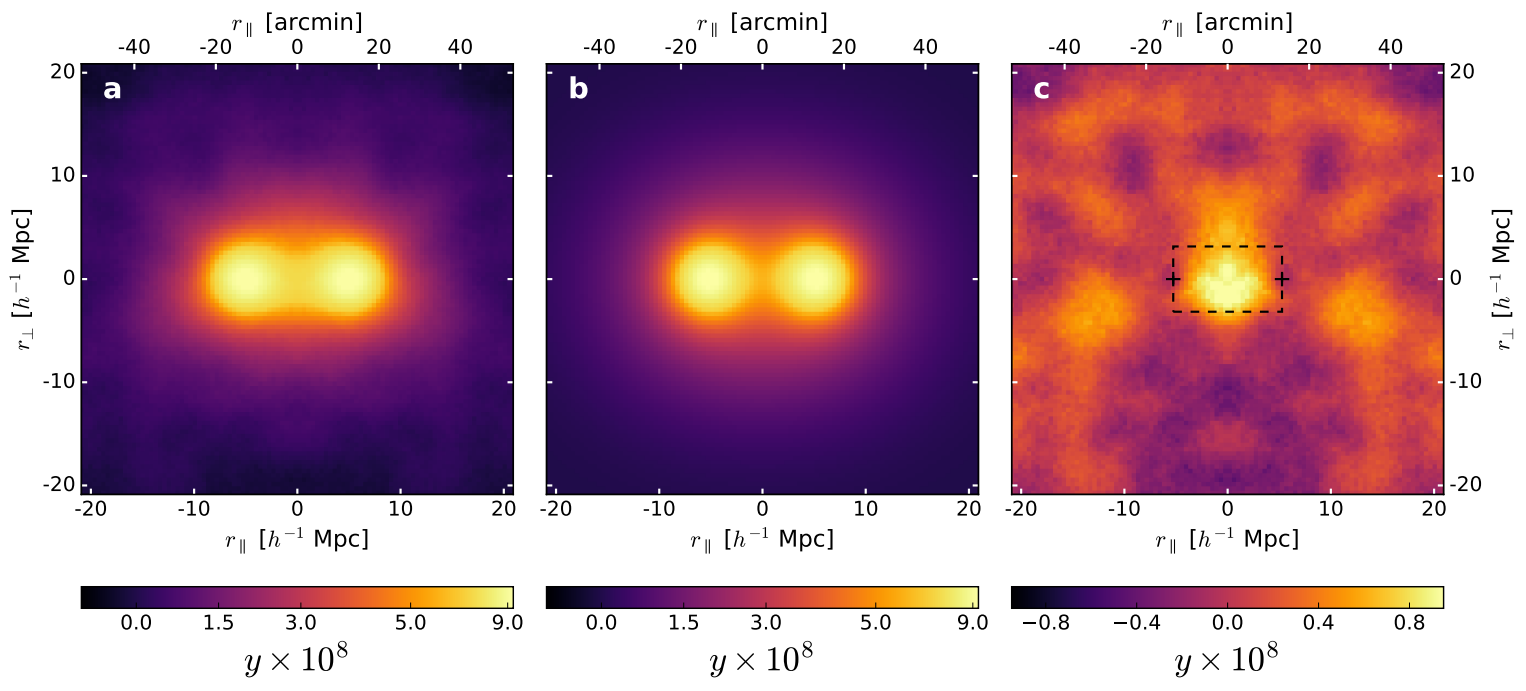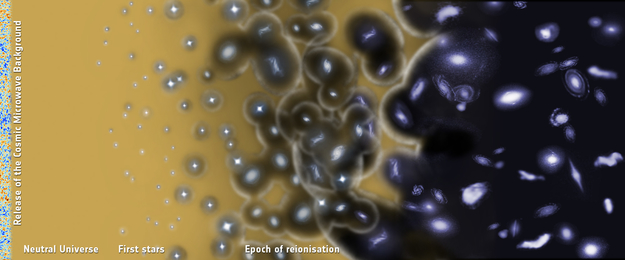In the gas filaments between the galaxies found half of the missing ordinary matter in the universe

The effect of Sunyaev-Zeldovich for 1 million pairs of galaxies next to each other. (a) symmetrically aligned Compton maps for 1 million close CMASS galaxy pairs; (b) a simulated signal only from galactic halos; (c) residual difference between the image of the pairs of galaxies next to each other and the simulated signal. The color corresponds to the strength of the Sunyaev-Zeldovich effect in terms of the dimensionless y-parameter, which is related to the pressure of the ionized gas. The connecting bridge between the pairs of galaxies is present in the image (a), but is missing in the image (b), which indicates the presence of a thread between the pairs of galaxies in the image (a). The detected thread is indicated in the illustration (c) in the form of a dotted rectangle, on which the positions of pairs of galaxies are marked with crosses.
The approximate mass distribution in the Universe is as follows: 5% falls on ordinary matter, of which visible stars and planets consist, 25% falls on dark matter (it is not visible, but is observed through gravitational effects), and 70% falls on dark energy (unknown substance which was “invented” to explain some cosmic phenomena, including the geometrically flat structure of the Universe and the apparent acceleration of its expansion).
But the calculations of astrophysicists have shown that the usual substance in the universe should be twice as much as we are seeing at the present time, writes New Scientist . Now about half of the "missing" baryons are finally found.
The discovery was almost simultaneously announced by two groups of researchers. Earlier, there was a Hideki Tanimura group with colleagues from the Department of Physics and Astronomy at the University of British Columbia (Canada), the Canadian Institute of Advanced Studies, the Research Institute of Astrophysics at the Liverpool John Moors University (United Kingdom) and the Astrophysics and Cosmology Department of the School of Chemistry and Physics at the University of KwaZulu-Natal (Durban, South Africa).
Two weeks later, Anna de Graaf and colleagues at the Royal Observatory of the Institute of Astronomy at the University of Edinburgh (United Kingdom) posted their article .
At the moment, the corrected second versions of both articles are posted on arXiv.org.
What did scientists find? Both groups of astrophysicists reported the discovery of a large amount of “lost” substance in the form of baryons. Baryons unite galaxies through threads of a hot diffuse gas.
As scientists have found out in past years, all the galaxies in the universe are connected together in a single network with the help of filaments, which consist of ordinary matter and dark matter. At first it was assumed that only dark matter binds galaxies, but in 2012 astrophysicists first discovered normal matter in these threads . For example, the Andromeda galaxy (M31) and the Triangle (M33) binds a strand of hydrogen 782,000 light-years long . Scientists have calculated that normal matter is approximately 10% of the total mass of the filaments , and the bulk is dark matter.
“The problem of missing baryons has been resolved,” said Hideki Tanimura from the Department of Physics and Astronomy at the University of British Columbia (Canada), lead author of the first scientific work.
Since the threads from the hot diffuse gas are very rarefied and not hot enough for X-ray telescopes, nobody noticed them before. We simply do not have a suitable tool to clearly register their presence, so the threads between the galaxies have so far remained a speculative theory. Now for the first time they are clearly recorded and studied.
Both groups used the same method to detect filaments. They applied the Sunyaev-Zeldovich effect, which is observed if the light left from the Big Bang passes through the clouds of hot gas. While passing through gas, this light scatters electrons from the cloud, leaving a dull mark in the cosmic microwave background - a kind of photograph from the time when the cosmos was born.

Cosmic reionization, the formation of the first stars after the Big Bang. Illustration: ESA
Both groups of researchers selected pairs of galaxies from the Sloan Digital Sky Survey database, which are supposed to be connected by baryon veins. The Tanimura group studied 260,000 pairs of galaxies, and the Anne de Graaf group studied more than 1 million pairs. Both groups revealed clear evidence of gaseous strands between galaxies. According to Tanimura and his colleagues, the density of matter in gas filaments is almost three times the density of normal matter in the Universe, and according to de Graaf, filaments are six times denser than normal matter.
Tanimura explained that the difference in assessment is due to the fact that the groups examined the threads that are at different distances. Given this factor, the results are not contradictory.
So, for decades, simulations of the Universe have shown the presence of unrecorded baryons in it - and here they are finally found. “Everyone knew they should be here, but for the first time, someone — even two different groups — made an unconditional definition,” says Ralph Craft of the Harvard-Smithsonian Center for Astrophysics in Massachusetts.
This discovery confirms once again that the simulation of the Big Bang, the emergence of our Universe from one point, the reionization, the formation of galaxies and filaments of dark matter between them - all this is calculated by scientists quite accurately. The theory is confirmed by observations.
Scientific articles are published on the site of preprints arXiv.
The article by Hideki Tanimura et al. Was published on September 15, 2017 (arXiv: 1709.05024v1).
The article by Anne de Graaf et al. Was published on September 29, 2017 (arXiv: 1709.10378v2).
All Articles